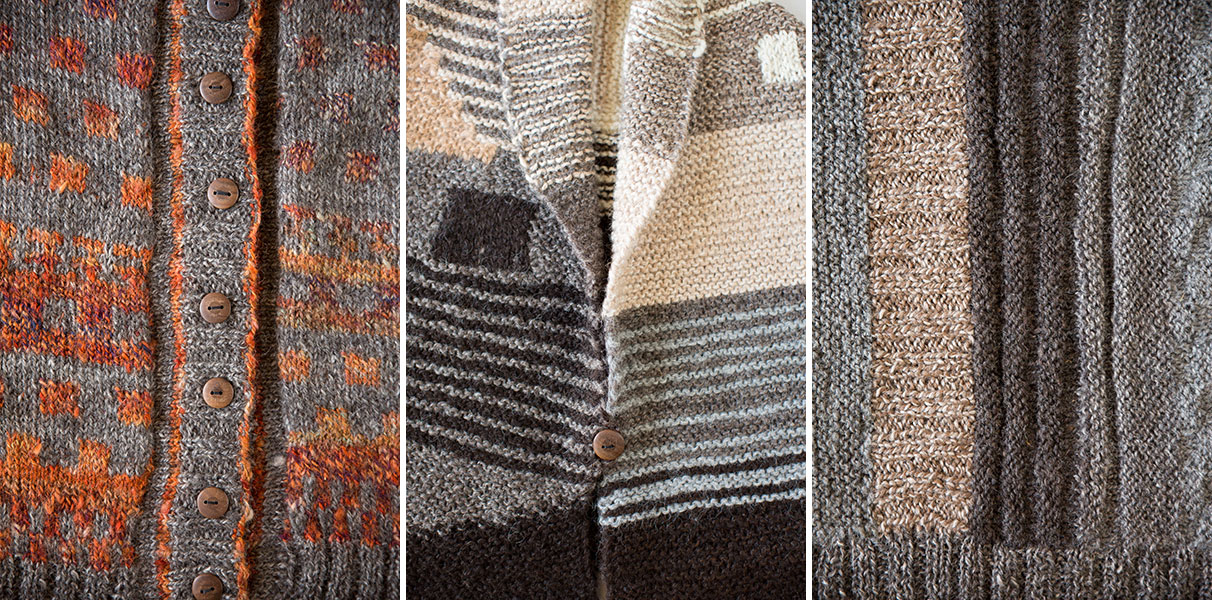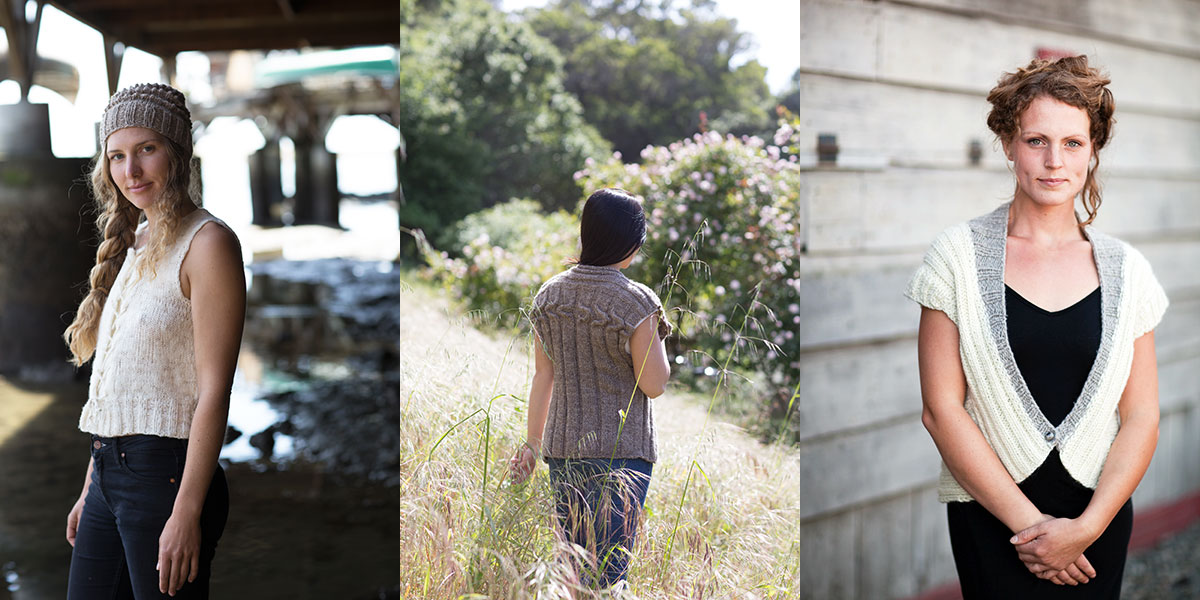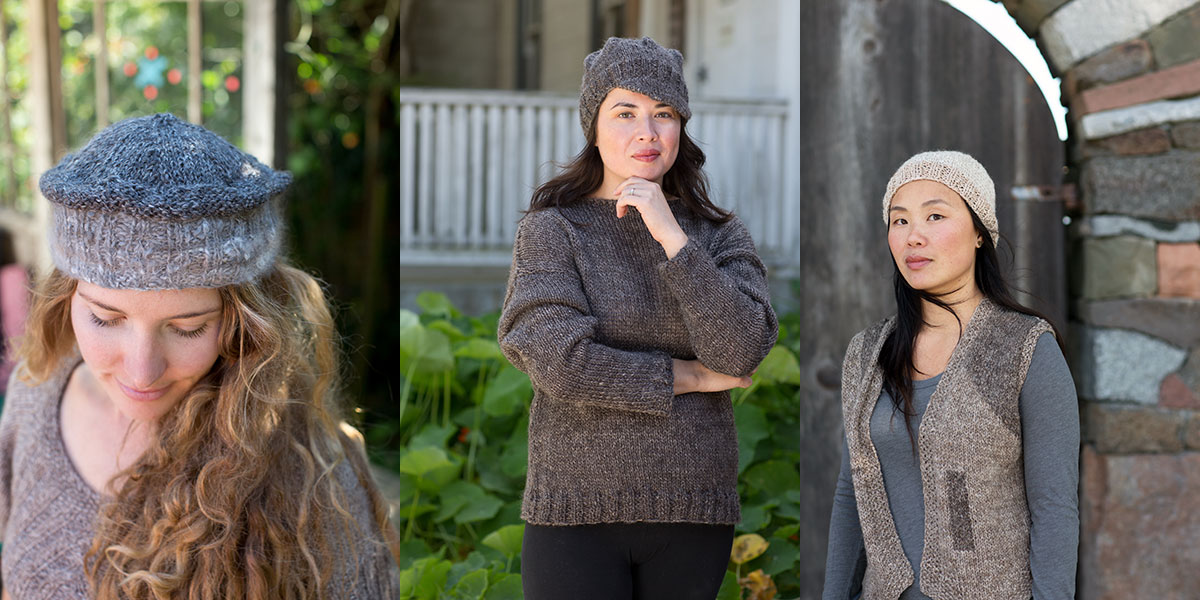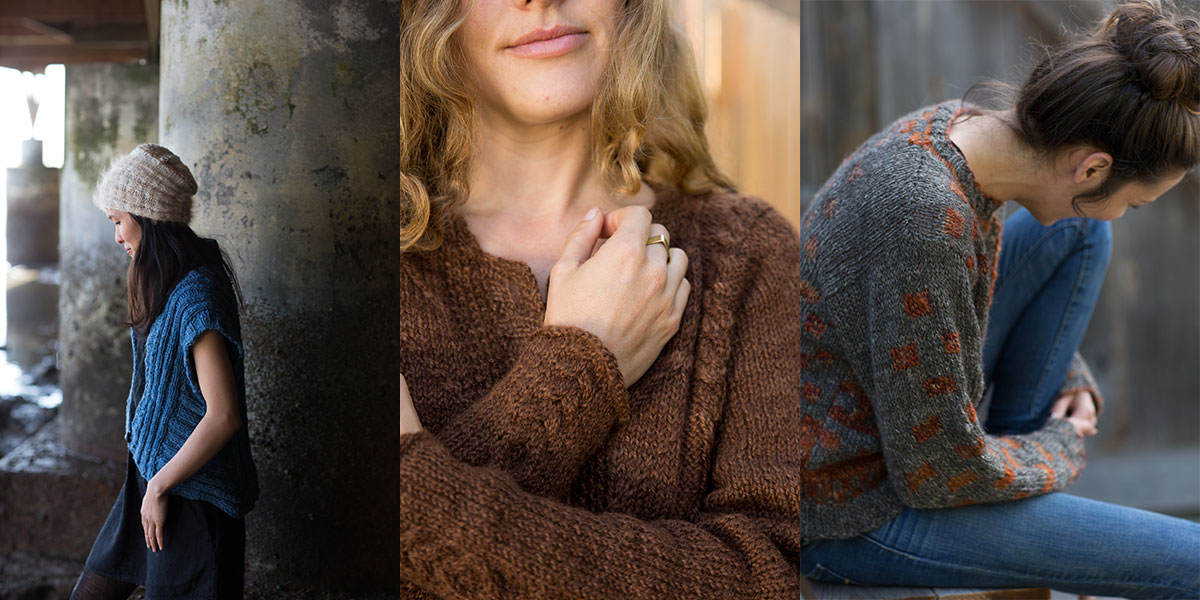Written by Dustin Kahn, Photography by Paige Green

Marlie (center) spins yarns for her designs—modeled on the beach in her home of Bolinas (left) and in her lush garden (right).
It’s an amazingly beautiful day in Bolinas, the little town in West Marin known for its unconventional inhabitants. I’m here to visit Marlie de Swart—and as I step into her home, I am struck by how clearly it reflects the creativity of Marlie and her husband, Bruce, as well as Marlie’s family of origin. Original paintings adorn the walls, hand carved wooden sculptures and furniture abound, as well as unique ceramic works. And all the signs of a fiber artist are present—from spinning wheels and knitting needles to plenty of exquisite fiber. And then there is the warmth of Marlie herself, smiling widely and welcoming me to sit among the lush landscape of her patio and eat freshly prepared food from ceramic dishes that she made. Does it get any better than this?
A valuable resource for fiber lovers in the Bay Area and beyond, Marlie has literally a lifetime of experience in the fiber arts, which she offers in the form of knitting groups and classes to attend, handmade wool garments for sale, knit kits, and now a book of her spectacular knitting patterns—Knitting Woolscapes. Most weekends she can be found at Black Mountain Artisans, her store in Point Reyes Station that operates as a fiber artist co-op.

Marlie has had a fascinating life journey, beginning some 60-odd years ago when she was growing up in Holland among a creative family—her father and all his siblings were artists, her mother was a “major knitter,” and her mother’s two sisters were nuns that taught fiber arts to high school students. “My aunts would come over, and everybody would just learn to knit, sew, spin, work with fiber, make rugs—we did it all!”
After graduating from high school—during which time she made all sorts of fabric wall hangings with applique work to both sell and give as gifts—Marlie spent a year in California, staying with her uncle. Returning to Europe, she studied at the Sorbonne in Paris for a year, until she was able to return to California and study fine art at Occidental College, where she received a full scholarship for teaching a foreign language. Marlie continued her studies in fine art at Art Center College of Design in Pasadena, where she met her American husband, Bruce, who was a student of interior design.
Once they graduated from Art Center, Marlie and Bruce lived in Amsterdam for three years, where they worked for a large department store doing interiors and installations. It was during that time that Marlie developed her skill as a spinner, as she describes here: “There are a lot of sheep in Holland, which are grazed on the dikes. A friend would get fleeces from a farmer and bring about 6 or 7 of them to me each year. I would spread them out on the floor, and clean, spin and knit the wool. My whole wall was covered with skeins of yarn that I hung there, most of it white, and some I would dye. When I returned to the US, I sold all the yarn or gave it away. But that’s when I really learned how to spin well, in my early twenties.”

Marlie and Bruce returned to the US and settled in San Francisco, where one of Marlie’s brothers was living at the time. Both of her brothers are artists—one in Holland working in glass and the other now in Inverness working in wood. Marlie mentions that she was meant to be an artist as well, with ceramics and fiber arts, but got waylaid in order to earn a living. And thus her career was in the software industry, and fiber arts were on the back burner. She continued to knit and spin when possible, but was traveling much of the time for work.
Although working in software seems surprising for someone trained in the arts, it makes sense when Marlie explains that the way she got into software was through languages; she managed translators who were working on software manuals, and then became a product manager. Eventually she and a friend from England started their own company and were consultants to software companies, setting up offices for them abroad.
Marlie found the work that she was doing interesting, but it involved an enormous amount of travel and was therefore quite exhausting. So, at age 50, she realized that if she wanted to make a change, she should do it now. Bruce was a designer for commercial interiors, and had just finished a major project in Japan, so they sold their house in San Francisco and moved to Bolinas, to a place they had bought a few years earlier as a weekend house.

Once she moved to Bolinas, Marlie joined the Black Mountain Weavers as a co-op member. The store wasn’t doing well, however, so she offered to buy it and keep it as a co-op, changing the name to Black Mountain Artisans. Since then the store has been doing quite well, and continues to welcome new fiber artists—either active members who spend some time working there to get a higher commission, or those who simply have their goods sold in the store.
When not at the store, Marlie works in her home studio, designing and creating knit goods inspired by the colors, shapes and textures found in nature, under her label of Bo-Rage Yarns and Designs. (The influence of nature can also be seen in her ceramics, though she has not been working in that medium lately.) Marlie’s specialty is hand-spun yarn and garments from locally sourced fleece. She bought her first local fleeces over 20 years ago, from friends in Dogtown who had Jacob sheep. Marlie met Mimi Luebbermann of Windrush Farm about 18 years ago, and not only began to buy fleece from her, but they started to teach together, which they still do at the annual Windrush Fiber School at Mimi’s farm in Petaluma. Otherwise Marlie teaches occasionally at other schools—including a class in designing hand spun yarn at West County Fiber Arts in Sebastopol, coming up on September 18th.

Marlie spinning with her long-time friend, Mimi Luebbermann (left), and displaying her hand made garments at Fibershed’s Grow Your Jeans event last fall (right).
These days most of the fleeces that Marlie buys are from Mimi Luebberman, Martha Cant of Starbuck Station Wools in Freestone, and Sandy Wallace of Alpacas of Marin in Nicasio. Her love for these natural colored fleeces is apparent in her creations, though she sometimes adds some botanically dyed details when creating Fibershed certified garments. In addition to her hand spun yarn, Marlie sends about two thirds of the wool and alpaca she buys each year to Yolo Wool Mill, where it is spun into blended yarns. If you can’t make it to Marlie’s store, some of her knit kits can be found on Marlie’s new website for her yarn and design company, which she calls Bo-Rage (her studio is in BOlinas, where she often creates outRAGEous designs).
After successfully designing and selling knit garments for many years, Marlie decided it was finally time to publish a book of patterns. The only issue being that she had never read patterns before she started to create them for the book! But this didn’t stop her, and as she learned how to write patterns she changed her approach in order to make a better pattern.

All of the patterns have now been test knitted, the photographs of the garments have been shot, and the book has been designed and is hot off the press. Marlie claims that had she known what she was getting into, she never would have taken on the project, so it’s lucky for us she didn’t know what a huge undertaking it would be. All of that hard work has come to fruition with her beautifully diverse book of patterns, Knitting Woolscapes, Designs Inspired by Coastal Marin Wool, now available online at borageyarns.com, as well as at Black Mountain Artisans and on the Fibershed Marketplace website. There are 25 patterns to be found in the book—for sweaters, vests, cardigans and hats—several of them pictured throughout this post, with stunning photography by Paige Green.
Now that the book is done, Marlie has more time to enjoy the beautiful life she has created—where fiber will always have a place in her heart and hands.

